In the late 1800s, male Chinese immigrants were brought to the U.S. to work on the railroads and as agricultural labor on the West Coast; many also specialized in laundry services. Some came willingly, others were basically kidnapped and brought forcibly.
After the transcontinental railroad was completed, it occurred to white Americans that Chinese workers no longer had jobs. They worried that the Chinese might compete with them for work. In response, a wave of anti-Chinese (and, eventually, anti-Japanese) sentiment swept the U.S.
Chinese men were stereotyped as degenerate heroin addicts whose presence encouraged prostitution, gambling, and other immoral activities. A number of cities on the West Coast experienced riots in which Whites attacked Asians and destroyed Chinese sections of town. Riots in Seattle in 1886 resulted in practically the entire Chinese population being rounded up and forcibly sent to San Francisco. Similar situations in other towns encouraged Chinese workers scattered throughout the West to relocate, leading to the growth of Chinatowns in a few larger cities on the West Coast.
The anti-Asian movement led to the Chinese Exclusion Act of 1882 and the Gentlemen’s Agreement (with Japan) of 1907, both of which severely limited immigration from Asia. Support was bolstered with propaganda.
Here is a vintage “Yellow Peril” poster. The white female victim at his feet references the fact that most Chinese in the U.S. were male–women were generally not allowed to immigrate–and this poster poses them as a threat to white women and white men’s entitlement to them:
“Why they can live on 40 cents a day…and they can’t,” this poster says, referring to the fact that white men can’t possibly compete with Chinese workers because they need to support their moral families. The Chinese, of course, usually didn’t have families because there were almost no Chinese women in the U.S. and white women generally would not marry a Chinese man.
The following images were found at the The History Project at the University of California-Davis.
This is the cover for the song sheet “The Heathen Chinese”:
According to the History Project, this next image was accompanied by the following text:
A judge says to Miss Columbia, “You allowed that boy to come into your school, it would be inhuman to throw him out now — it will be sufficient in the future to keep his brothers out.” Note the ironing board and opium pipe carried by the Chinese. An Irish American holds up a slate with the slogan “Kick the Heathen Out; He’s Got No Vote.”
The following counter-propaganda pointed out how immigrants from other countries were now working to keep Chinese immigrants out. The bricks they’re carrying say things like “fear,” “competition,” “jealousy,” and “non-reciprocity.”
During World War II, attitudes toward the Chinese shifted as they became the “good” Asians as opposed to the “bad” Japanese. However, it wasn’t until the drastic change in immigration policy that occurred in 1965, with the passage of the Immigration and Nationality Act, that Asia (and particularly China) re-became a major sending region for immigrants to the U.S.
This post originally appeared in 2008.
Gwen Sharp is an associate professor of sociology at Nevada State College. You can follow her on Twitter at @gwensharpnv.


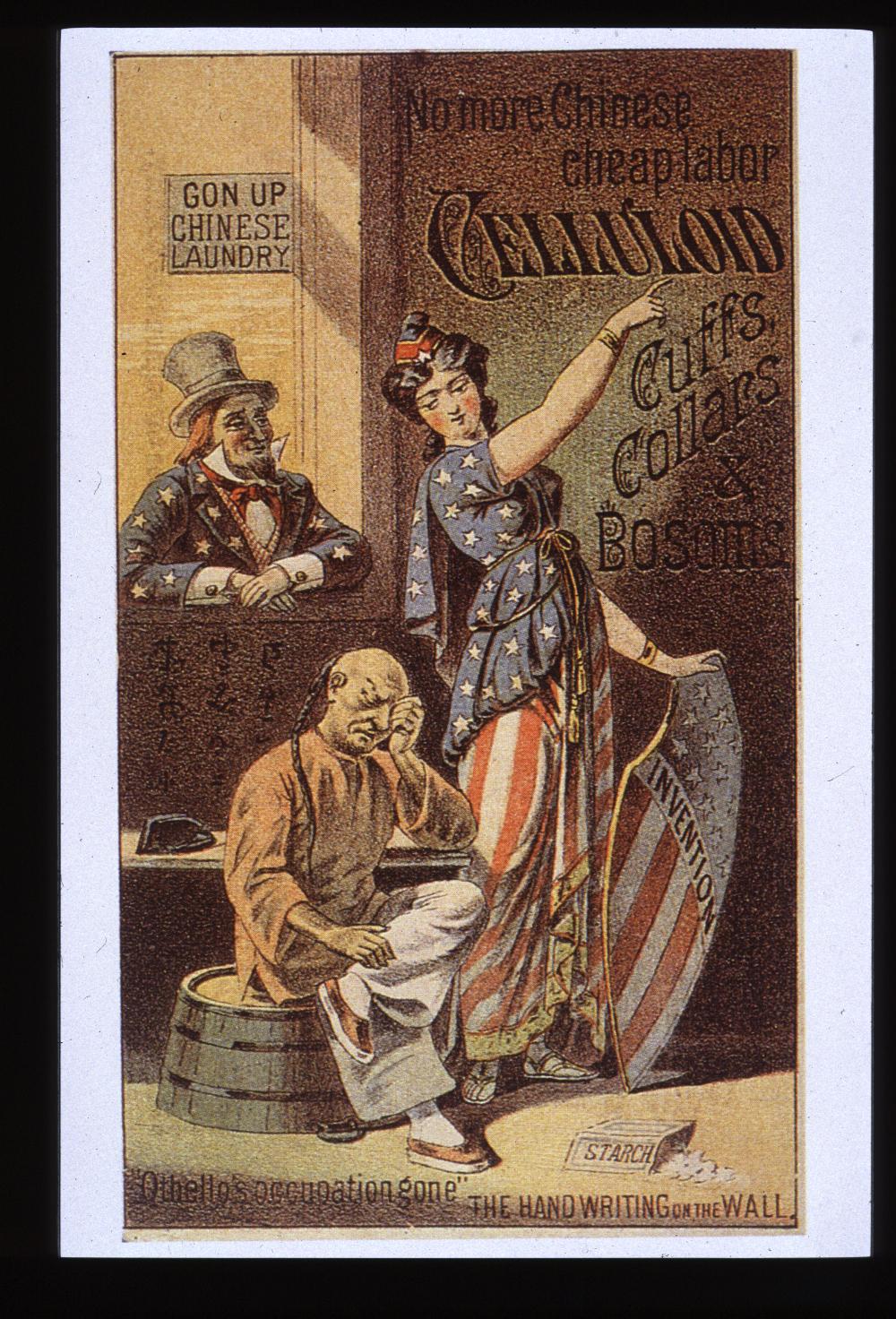
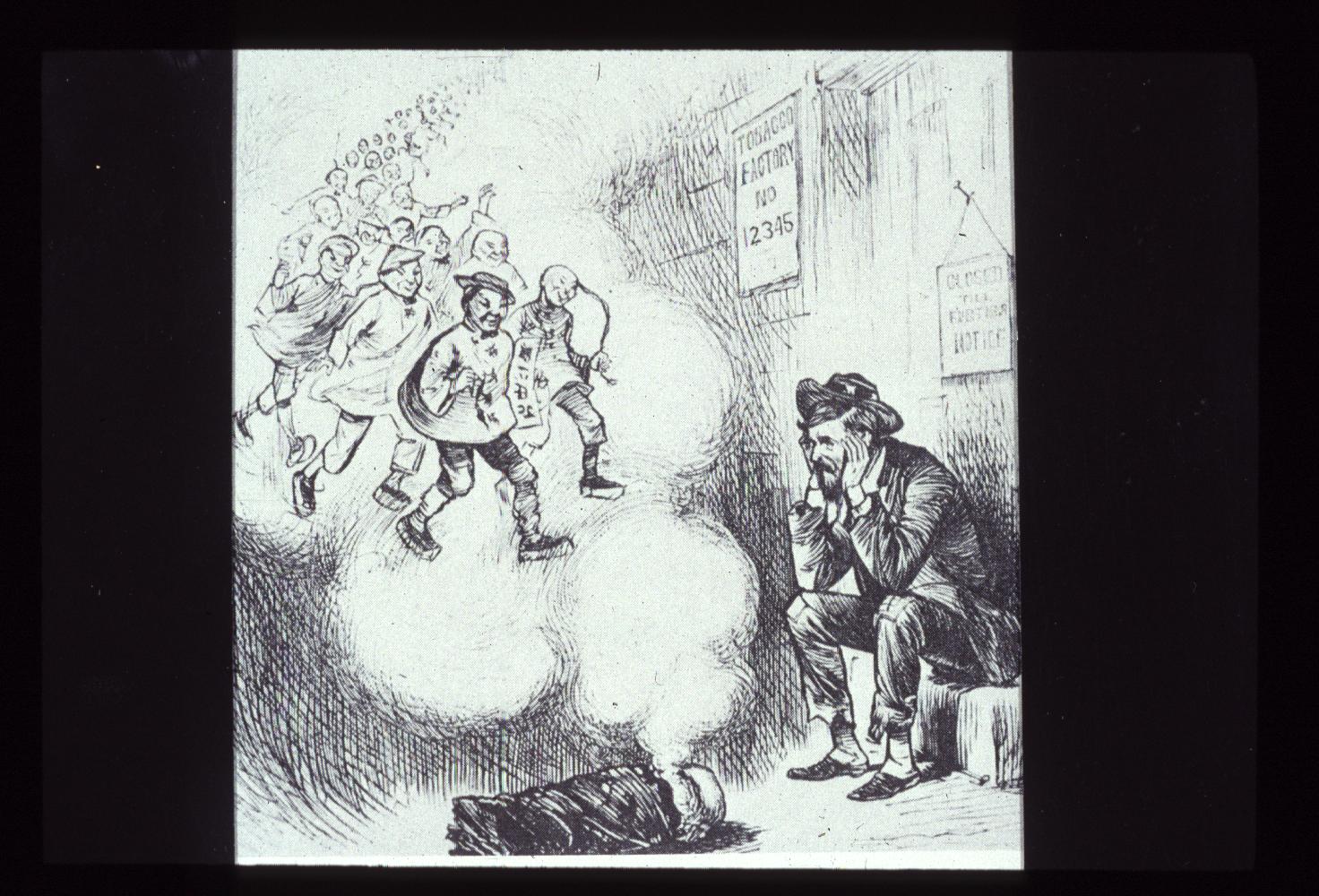
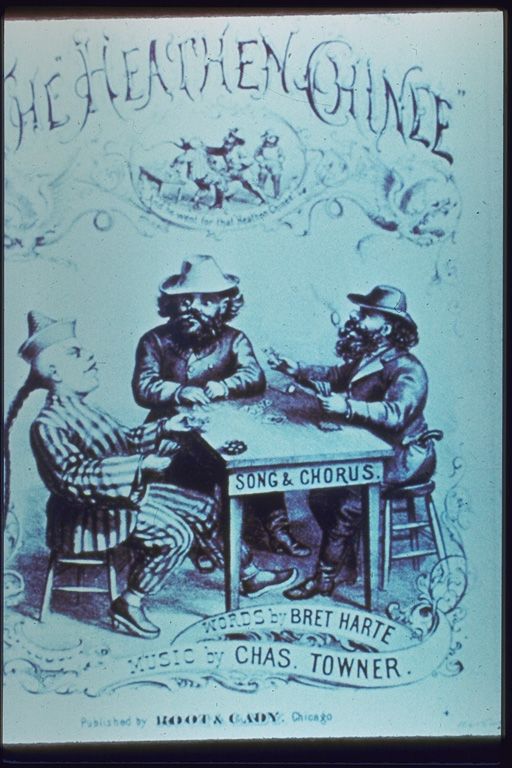
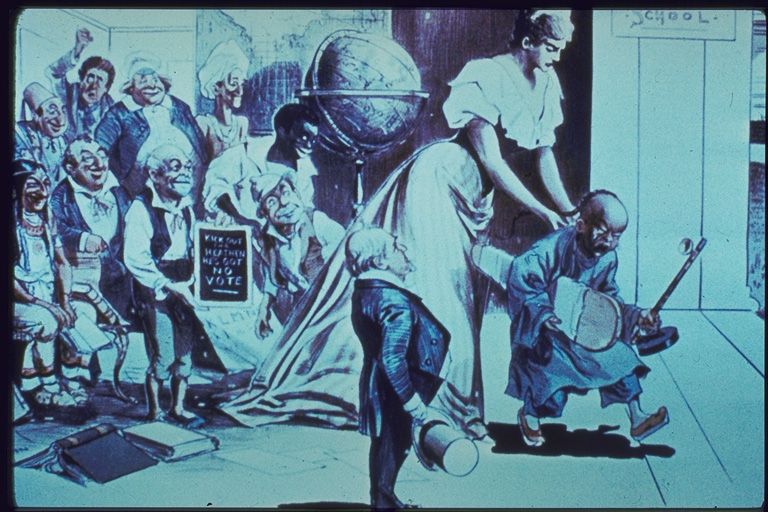
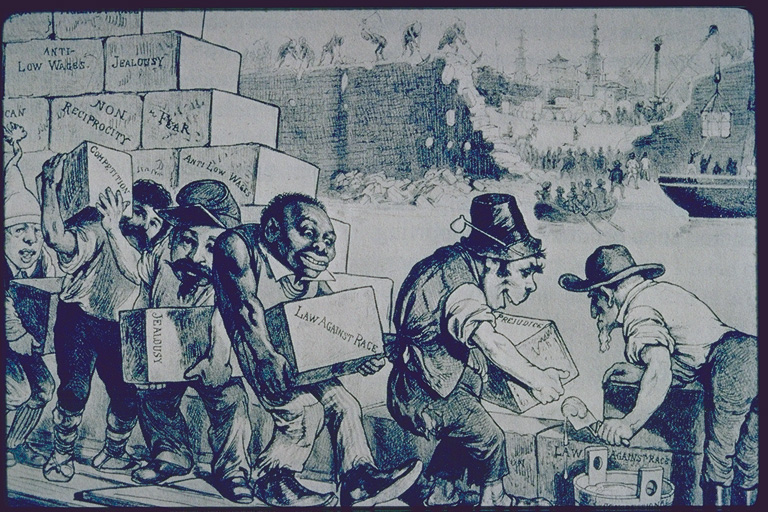
Comments 67
Elena — July 8, 2008
"During World War II, attitudes toward the Chinese shifted as they became the “good” Asians as opposed to the “bad” Japanese."
Milton Caniff was commissioned to do a quick guide for telling Chinese and Japanese people apart... not that the Chinese are in any way an homogeneous population!
mike — July 8, 2008
Closer inspection on the image for "The Heathen Chinese" actually shows it says "The Heathen Chinee". Charming.
73man — July 9, 2008
One of the finest caricatures of an Irish immigrant I have seen. And look! the little fella is carrying a block named 'prejudice'. Oh how times have changed.
Sociological Images » Stereotyping Scots as Cheap — July 4, 2009
[...] stereotypes of European ethnic groups, see our post on images of the Irish. We also have some old anti-Chinese posters. tags: change, history, race/ethnicity| Permalink| Happy Birthday, Robert Merton [...]
Collective Action And The Frito Bandito » Sociological Images — August 10, 2009
[...] more racial and ethnic stereotypes in marketing and in these posts: the Chinese (here, here, and here), American Indians (here and here), Black Americans (here and here), and the Irish. [...]
What We’ve Been Up To Behind Your Back (August 2009) » Sociological Images — September 1, 2009
[...] found a rodent control ad comparing the Chinese to rats and added it to our long list of anti-Chinese propaganda circa 1900. We also added an image of lemon ice cream marketed with a caricatured Asian image to a prior [...]
Traffic Lights Featuring Female Figures » Sociological Images — September 3, 2009
[...] And Astrid linked to some examples from Germany. [...]
Most Overexaggerated Occurance in History? - Page 15 - Historum - History Forums — May 2, 2011
[...] [...]
James Preller’s Blog » Blog Archive » James Preller Interviews . . . Lewis Buzbee, Author of “Bridge of Time” — January 10, 2012
[...] write powerfully about the discrimination experienced by the Chinese residents in San Francisco during the 19th century. The so-called “Chinese Menace” or “Yellow Peril.” For Joan [...]
Vicious Racism of US Capitalist Class Behind Hiroshima, Nagasaki, Korea, Vietnam – and China-bashing « Independent Workers Party – Chicago — August 8, 2012
[...] degree that they were extended to cover all non-white, Anglo-Saxon, Protestant peoples, from the Chinese to the Irish. Thus the white-skinned population of the United States has been propagandized to [...]
Where “Old” and “New” World Color Meet in Multiracial Asian America :: racismreview.com — November 18, 2013
[…] So what happens when huge numbers of Asian immigrants (430,000 in 2010) and students (6 in 10 international students are from Asia) start arriving Stateside and their colorist/class values meet US racism which has aggressively devalued and violently oppressed dark-skinned people for hundreds of years? What happens when White Perfect (above) meets Jim Crow? “Less yellowish” meets Yellow Peril? […]
Where “Old” and “New” World Color Meet in Multiracial Asian America :: racismreview.com | InnerStanding Isness — November 19, 2013
[…] So what happens when huge numbers of Asian immigrants (430,000 in 2010) and students (6 in 10 international students are from Asia) start arriving Stateside and their colorist/class values meet US racism which has aggressively devalued and violently oppressed dark-skinned people for hundreds of years? What happens when White Perfect (above) meets Jim Crow? “Less yellowish” meets Yellow Peril? […]
May 6, 1882: Race and immigration policy collide | Millard Fillmore's Bathtub — May 6, 2014
[…] Old “yellow peril” anti-Chinese posters, at The Society Pages; also, Cartooning the U.S. Chinese Exclusion Act […]
Bill R — June 21, 2014
Today's social critics can have a field day exploring 19th century America. The Chinese labor issue almost pales in comparison to slavery and the resultant civil war and the "relocation" of large numbers of Indians west of the Mississippi. And of course women were of lower stature than men. They couldn't vote and in most places couldn't own real property.
We are not perfect today but in a relatively short period of time we've come a very long way.
Schools in Revolt — September 10, 2014
[…] […]
Is Willa Cather’s “The Affair at Grover Station” a Work of Occult Detection? | timprasil — October 12, 2014
[…] at Grover Station” also has a prime suspect who makes this story very much a part of the Yellow Peril movement of the late 1800s and early 1900s. That suspect is a man named Freymark. Cather is far […]
t | veganracism — October 12, 2014
[…] http://thesocietypages.org/socimages/2014/06/20/old-yellow-peril-anti-chinese-posters/ […]
New Movie Spider-Man Should be Peter Park | thenerdsofcolor — February 13, 2015
[…] anyone acquainted with the Yellow Peril propaganda that historically plagued the Asian American community will find the yellow journalism of the Daily […]
For Tues 2/17 | Asian Pacific American Media — February 13, 2015
[…] On Tues 2/17 we will start our new unit. You can prepare by reading Ono and Pham, ch. 2, which I handed out in class on Tues 2/10. Also check out this blog post, Old “Yellow Peril” Anti-Chinese Propaganda. […]
Not Popping: Mis(sed)representations of Asian Men in Western Media - seoulbeats | seoulbeats — March 17, 2015
[…] images presenting the “Yellow Peril” led to greater anti-Asian legislation, such as the Chinese Exclusion Act of 1882. Anti-Japanese propaganda in the early 1900s dehumanized the group — in turn serving as persuasive pieces to strip […]
Stereotypes | Breaking Hollywood's "Bamboo Ceiling" — May 4, 2015
[…] misguided Asian stereotypes have been a problem in the media, running the gamut from “Yellow Peril” archetypes, overly sexualized females, emasculated males, the perpetual foreigner and the model […]
[生活美語] 美國影集: 菜鳥移民 | Eric's English Lounge — June 25, 2015
[…] http://thesocietypages.org/socimages/2014/06/20/old-yellow-peril-anti-chinese-posters/ http://www.huffingtonpost.com/frank-h-wu/the-case-against-vincent_b_5237359.html […]
Quora — August 20, 2015
I find the term "Asian" incredibly inaccurate since Indians, Israeli, Iranians, and Russians are also in Asia. Why is it that some people get called white or black, but the word yellow for people from East Asia is considered racist? Is there any ot…
Because in English and in matters of psychosociology the color yellow is associated with cowardice and treachery. This line of reasoning is similar to how the word negro as a Spanish word for the color black may be acceptable as in the case of its use…
Winter Quarter Blog #2: Friend or Foe? – A Take on War — January 16, 2016
[…] was a time period in U.S. history where people feared Asian immigrants called the “Yellow Peril“. It started in the late 1800s when the Chinese were brought over as cheap labor. Many feared […]
Map imagining Japanese attack of the West Coast of the United States, four years before Pearl Harbor. – Slinking Toward Retirement — April 12, 2016
[…] anti-Japanese throughout the early 20th century; “Hearst didn’t coin the phrase ‘yellow peril,’ but he used it early, often and […]
Asian Masculinity Is Not A Contradiction – vergeofeverything — April 15, 2016
[…] of the fear of yellow peril and the movies made about the character. Fu Manchu is the embodiment of yellow peril – the fear that Asians and Asian Americans are somehow plotting to infiltrate America through […]
Obama Signs Bill Removing 'Oriental' and 'Negro' From Federal Laws – Silver-Legacy — May 23, 2016
[…] The word evokes anti-Asian sentiment from the nation’s history, including racist “Yellow Peril” stereotyping; the Chinese Exclusion Act of 1882; and the Oriental […]
Obama Signs Bill Removing 'Oriental' and 'Negro' From Federal Laws - LiberalVoiceLiberalVoice — Your source for everything about liberals and progressives! — News and tweets about everything liberals and progressives — May 23, 2016
[…] The word evokes anti-Asian sentiment from the nation’s history, including racist “Yellow Peril” stereotyping; the Chinese Exclusion Act of 1882; and the Oriental Exclusion Act of […]
Obama Signs Bill Removing 'Oriental' and 'Negro' From Federal Laws « CauseHub — May 23, 2016
[…] The word evokes anti-Asian sentiment from the nation’s history, including racist “Yellow Peril” stereotyping; the Chinese Exclusion Act of 1882; and the Oriental […]
Obama Signs Bill Removing ‘Oriental’ and ‘Negro’ From Federal Laws — May 23, 2016
[…] The word evokes anti-Asian sentiment from the nation’s history, including racist “Yellow Peril” stereotyping; the Chinese Exclusion Act of 1882; and the Oriental […]
Obama Signs Bill Removing ‘Oriental’ and ‘Negro’ From Federal Laws | BlogFactory — May 24, 2016
[…] The word evokes anti-Asian sentiment from the nation’s history, including racist “Yellow Peril” stereotyping; the Chinese Exclusion Act of 1882; and the Oriental […]
Venturuso - Hispanic Venture Capital News — May 25, 2016
[…] The word evokes anti-Asian sentiment from the nation’s history, including racist “Yellow Peril” stereotyping; the Chinese Exclusion Act of 1882; and the Oriental […]
Why Americans condemn Chinese for eating 15,000 dogs before July 4th – Gan ma? — July 5, 2016
[…] Old Yellow Peril propaganda, caption reads, “Why they can live on 40 cents a day. And they can’t” via thesocietypages […]
4 Racist Stereotypes White Patriarchy Invented to 'Protect' White Womanhood — Everyday Feminism — July 10, 2016
[…] was widespread to perpetuate these stereotypes. Chinese men were portrayed as men who strategically stole white men’s jobs and tricked white women; Japanese men were […]
Remembering the Chinese Exclusion Act – Anagnorisis and Peripeteia — September 5, 2016
[…] “The Yellow Terror in All His Glory” (1899) Find original image and other propaganda pictures here. […]
Paul Muschamp — October 14, 2016
hi brad
Paul Muschamp — October 14, 2016
'''''''''' Immigration''''''''''
Paul Muschamp — October 14, 2016
Immigration reminds me of that movie with dyane johnson
bimantara bimo — November 12, 2016
does anyone know who have a source 'bout yellow peril theory??
San Diego Asian Film Festival brings Taiwan Showcase to UCSD | THE TRITON — December 6, 2016
[…] at UC San Diego, bringing the festival to the students for free. With America’s past of the Yellow Peril Movement and the continued history of yellow face, the SDAFF is central to the future of East Asian […]
Dear Adoptive Parents of Overseas Adoptees: Wake Up! — February 2, 2017
[…] Just yesterday, CNBC published an article with the headline, “US-China war increasingly a ‘reality,’ Chinese army official says” (Steve Bannon has also said that he thinks it will happen in the next 5-10 years. Listen to how much contempt he has. It’s the new yellow peril.) […]
Why Asian Americans Don’t Vote: A Theoretical Perspective – Berkeley Political Review — November 18, 2017
[…] had expired. The CEA had come around a time in the 1800s where thousands of Chinese laborers had completed the Transcontinental Railroad, and white Americans were now worried that their jobs would be lost given a number of laborers that […]
From the Peril – Inequalitywho — November 19, 2017
[…] https://thesocietypages.org/socimages/2014/06/20/old-yellow-peril-anti-chinese-posters/ […]
Political Cartoons – Various Authors – Conflicts & Conversations: A Postbellum Activist Anthology — May 17, 2019
[…] Sharp, Gwen. “The Yellow Terror in All His Glory.” site title: Sociological Images: Old “Yellow Peril” Anti-Chinese Propaganda. 20 June 2014. April 2019. https://thesocietypages.org/socimages/2014/06/20/old-yellow-peril-anti-chinese-posters/ […]
Calator Roman — December 2, 2019
Hello, this weekend is nice designed for me, because this time i am reading
this impressive informative paragraph here at my home.-
calator.tel
After 170 Years, the 'Sideways Asian Vagina' Myth Still Won't Go Away — January 15, 2020
[…] working-class white laborers by working harder for lower pay. But while Chinese men were reduced to dirty and criminal rat-tailed fiends, the women were viewed as undesirable prostitutes with unorthodox sex organs. And […]
MaKaylei Vasquez — January 24, 2020
The Yellow Perial is a racist color metaphor that the people of
East Asia are a danger to the Western world. Asian men couldnt have white women.
The return of the Yellow Peril: Why coverage of COVID-19 is reviving a culture of discrimination against East Asians – Roar News — March 9, 2020
[…] that we lived off of eating vermin to provide cheap labour in order to compete with white workers. The propaganda was widely distributed and state-sanctioned in the US and the UK. However, a lot of the Chinese immigrants who had these claims directed towards them only came to […]
The Saker: "The AngloZionists are launching a strategic PSYOP against China" — April 23, 2020
[…] Anti-Chinese propaganda has a long history in the USA and it was really easy to re-kindle it. […]
The AngloZionists are launching a strategic PSYOP against China | SALAM ALQUDS ALAYKUM - سلام القدس عليكم — April 23, 2020
[…] Anti-Chinese propaganda has a long history in the US and it was really easy to re-kindle it. […]
The AngloZionists Are Launching a Strategic PSYOP Against China – The Mad Truther | A Sweet Dose of Reality — April 23, 2020
[…] Anti-Chinese propaganda has a long history in the US and it was really easy to re-kindle it. […]
The AngloZionists are Launching a Strategic PSYOP against China - The Falling Darkness — April 23, 2020
[…] Anti-Chinese propaganda has a long history in the USA and it was really easy to re-kindle it. […]
The AngloZionists are launching a strategic PSYOP against China – The Greanville Post — April 23, 2020
[…] Anti-Chinese propaganda has a long history in the USA and it was really easy to re-kindle it. […]
Anglo-sionistas lançam Operação Psicológica contra a China - Notícias da Bahia — April 25, 2020
[…] A propaganda anti-chineses tem longa história nos EUA e foi realmente fácil reacendê-la. […]
Los anglosionistas están lanzando una PSYOP estratégica contra China | √ HO1 – Holistic Overview #1 - The #1 AIO* Holistic View to understand several topics better ! — April 25, 2020
[…] La propaganda anti-china tiene una larga historia en los Estados Unidos y fue muy fácil reavivarla.2.- La mayoría de los estadounidenses tienen una […]
Anglo-sionistas lançam Operação Psicológica contra a China | √ HO1 – Holistic Overview #1 - The #1 AIO* Holistic View to understand several topics better ! — April 25, 2020
[…] 1. A propaganda anti-chineses tem longa história nos EUA e foi realmente fácil reacendê-la.2. Muitos norte-americanos têm reação completamente irracional à palavras “comunista”, de tal modo que é realmente fácil para qualquer panfleto de propaganda pró-EUA mencionar o Partido Comunista da China e a palavra “mentiras” na mesma frase e soar crível, não importa o que que digam frase e panfleto (do tipo, digamos, de prova factual).3. A plutocracia dos EUA está apavorada com o poder econômico e industrial dos chineses, daí a vilificação de empresas como Huawei ou DJI que são declaradas ameaça à segurança nacional dos EUA. Jogue todas as culpas sobre os chineses, e os oligarcas norte-americanos amarão!4. China e Rússia estão num relacionamento que é até muito mais profundo que uma aliança. Chamo de “simbiose”; os chineses falam de “parceria estratégica ampla de coordenação para a nova era”; os russos falam de uma “aliança crucial”. Os termos realmente pouco importam aqui; o que interessa é que Rússia e China estão lado a lado (é o que dizem com a palavra “coordenação”) contra o Império e que as tentativas (admitidamente poucas e canhestras) dos EUA para quebrar aquela aliança falharam completamente. […]
The AngloZionists Are Launching a Strategic PSYOP Against China – Emma Olive — April 28, 2020
[…] Anti-Chinese propaganda has a long history in the US https://thesocietypages.org/socimages/2014/06/20/old-yellow-peril-anti-chinese-posters/ and it was really easy to re-kindle […]
RASSEGNA STAMPA DETTI E SCRITTI 4 MAGGIO 2020 - Detti e Scritti — May 4, 2020
[…] Negli Stati Uniti la propaganda anti-cinese ha una lunga storia [in inglese] ed era davvero facile ravvivarla. […]
Начата стратегическая психологическая операция против Китая - inosmi.by — May 17, 2020
[…] У анти-китайской пропаганды в США долгая история и её очень легко возобновить. […]
Les Anglo-Sionistes lancent une PSYOP stratégique contre la Chine. par The Saker. – COLLECTIF NOVEMBRE POUR LE SOCIALISME — November 7, 2020
[…] 1- La propagande anti-chinoise a une longue histoire aux États-Unis et il a été très facile de la relancer. […]
Les Anglo-Sionistes lancent une PSYOP stratégique contre la Chine. par The Saker. – Ecole populaire de philosophie et de sciences sociales — November 13, 2020
[…] 1- La propagande anti-chinoise a une longue histoire aux États-Unis et il a été très facile de la relancer. […]
Implicit vs Explicit Racism | eliminato — June 28, 2021
[…] was widespread to perpetuate these stereotypes. Chinese men were portrayed as men who strategically stole white men’s jobs and tricked white women; Japanese men were […]
San Diego Asian Film Festival brings Taiwan Showcase to UCSD - The Triton — September 7, 2021
[…] at UC San Diego, bringing the festival to the students for free. With America’s past of the Yellow Peril Movement and the continued history of yellow face, the SDAFF is central to the future of East Asian […]
Dear Adoptive Parents of Overseas Adoptees: Wake Up! – My Sky List — November 2, 2021
[…] Just yesterday, CNBC published an article with the headline, “US-China war increasingly a ‘reality,’ Chinese army official says” (Steve Bannon has also said that he thinks it will happen in the next 5-10 years. Listen to how much contempt he has. It’s the new yellow peril.) […]
The AngloZionists are launching a strategic PSYOP against China | The Vineyard of the Saker — February 17, 2023
[…] Anti-Chinese propaganda has a long history in the USA and it was really easy to re-kindle it. […]